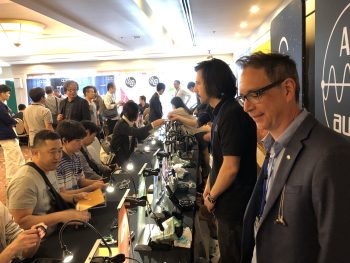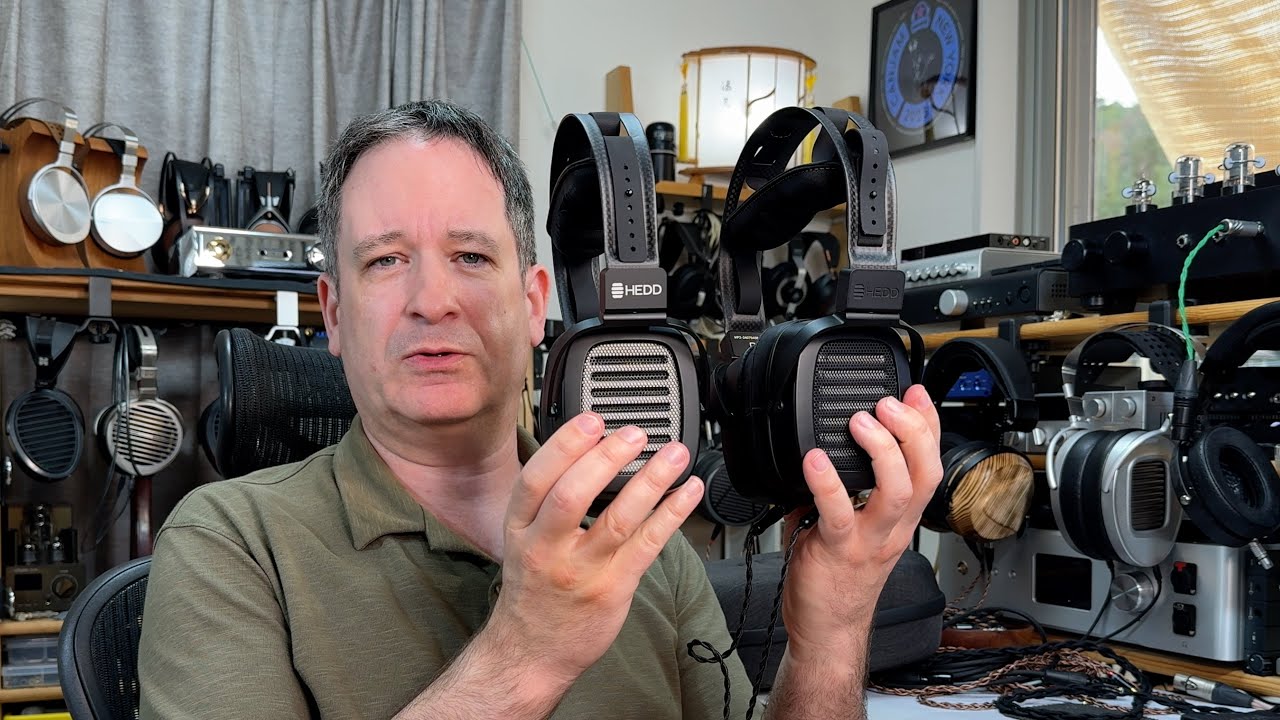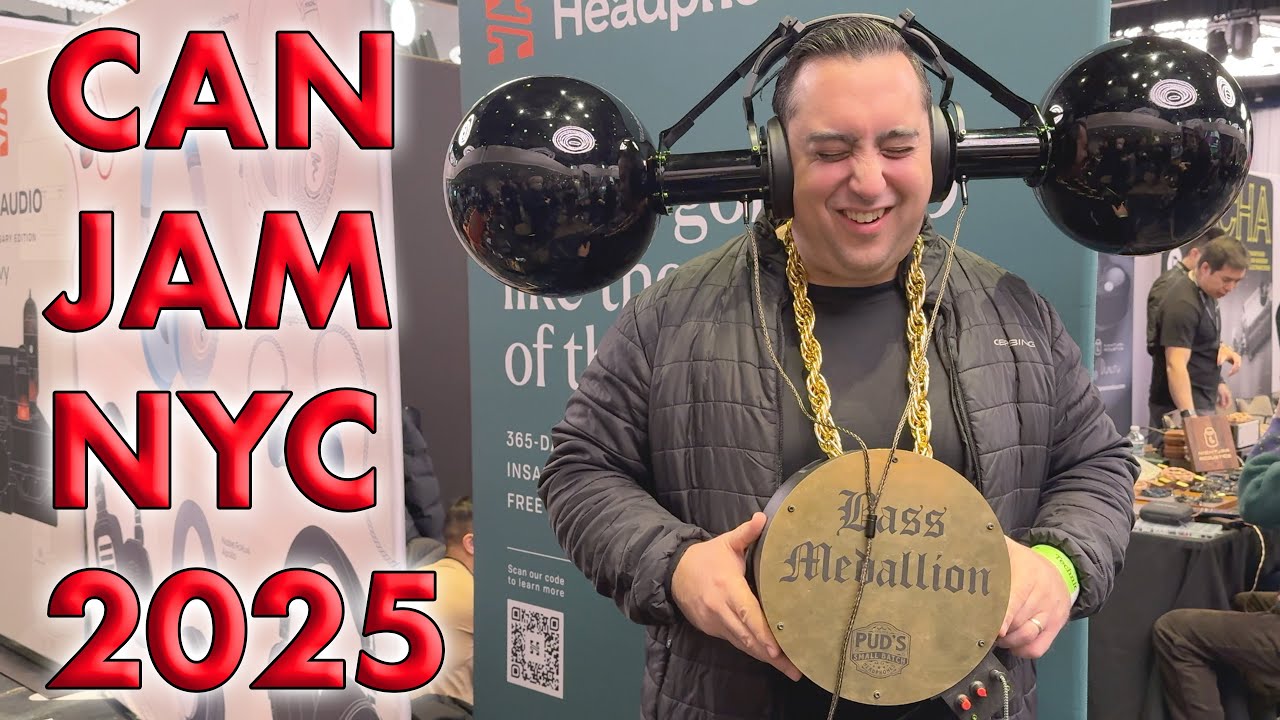Stax
Octave
E.A.R. Yoshino
Meze
Oriolus
DigiFi
MASS-Kobo
MASS-Kobo’s 404 amp was a lovely little amp for driving HD800s, but it lacked the current for serious planars. So Masanori Masuda, who usually makes pro-audio equipment, produced the Model 406. It’s not cheap though. At around the $18,000 mark it has 3.8W and 32V output (!!!) which is enough to do a good job with HiFiMan’s Susvaras, which it drove nicely when I had a listen. Balanced input only though.
Timelord (Ultrasone, Chord, Pathos)
I gave Ultrasone’s Edition 15 a listen, and I think I might have to borrow a pair for review. While at 2,499 Euro they compete with a lot of other serious headphones, they are starting to sound a bit more competitive than some of their past models.
What really got me though was a new amp from Pathos. Check out the heatsinks! I didn’t audition it as I hadn’t brought any familiar headphones with me, and anyway, it’s just enough to look at!
At the end of the last day I grabbed the guys from Audio Technica and the new ADX5000 and tried it with the Blu 2 + DAVE combo and some binaural tracks. That was almost as amazing to experience as the Orpheus system next door in Sennheiser’s room.
Campfire Audio
Ken Ball, Caleb and team were on hand with the new Atlas and Comet IEMs, as well as the Cascade headphones. The new models look as stunning as the pictures suggest, and despite the weightiness of the Atlas model, it sits in my ears comfortably. This time, instead of having a right-angle entry as the Vegas, the Atlas and Comet take advantage of the ability of the cable to swivel so you can wear the cable either straight down or around your ears.
They also have a new 4.4mm Pentaconn connector version of the cable.
The Atlas has a stunning sound with plenty of bass and a wonderful non-IEM-like treble. I’ll be posting a review of them soon.
Jaben Network (Phatlab, Elemental Amps)
Uncle Wilson was at the show and had a pair of old AKG K1000s being driven out of a pair of neat tube amps from Elemental Amps which can be run as a single or dual amps. With careful adjustment of the earpieces, I got some wonderful music out of the K1000s.
Re-Leaf
One of the most expensive devices at the show was the top-of-the-line Re-Leaf DAC/amp, the E1R. Re-Leaf don’t brand their amps anywhere on the outside, holding that their unique design speaks for itself. Certainly the futuristic look of the design is impossible to ignore, until you get fingerprints on it.
They had a new entry-level model at around the $5500 mark, the E3 hybrid which has both current mode and voltage mode outputs. It can be doubled up for extra power. The pair produced wonderful, fatigue free sound into a pair of HD800s.
YAXI Earpad
Dektoni were at the show, so it was something of a surprise to find that another company has been creating a range of after-market earpads as well, mainly for Fostex and Sony headphones, but including an upcoming model for the HD800. I had a quick listen with their HD800 pads and without comparison, the overall presentation was a bit better than I remember the stock HD800 sound to be, which usually has me wanting to switch to an aftermarket cable.
Korg NuTube
Korg had quite a demo of its NuTube, low-power tube replacement. Most of their display consisted of some interesting battery-powered kits. They also had what appeared to be a one-off amplifier and battery-powered analog filter (see the picture).
XI Audio
Xiao Qi, previously the marketing manager of Lotoo, left the company and has begun his own, XI Audio. He had on display some battery-powered amps (EDC flashlight types will immediately recognise the batteries). He also had an R2R DAC on display. Yes, it uses a Soekris board.
The amp comes in SE and balanced versions and was being demoed with HD800s, with which it does a good job. I took up the challenge when it was suggested they were dead silent, as I had Andromedas in my bag. Indeed, apart from a minute amount of background beeping from something, there was no hiss to speak of at the same gain I’d driven the HD800s. The DAC had a nice sound as well.
iFi Audio
The main crew of iFi were on hand to demonstrate the new Pro iDSD and the xCAN, a more powerful amp only version of the xDSD. Uniquely it has Bluetooth input, but otherwise the only other inputs are analog.
Shure
When we were first checking out the show guide we thought someone had made a typo in putting that Shure was showing the KSE1200, not 1500. I guessed immediately that they’d made a version without the DAC and I was correct. The tonal balance is still more K701 than anything, favouring acoustic music, ie: instruments and vocals and less interesting with anything that requires a good amount of bass kick, but the resolution is still fantastic. With 35dB of isolation that is good enough to use even on a plane.
I ran into Matt Engstrom of Shure towards the end of the show and he told me that in addition to removing the DAC, they had also changed the type of attenuator used in the KSE1200 as well.
ZMF
This was my first chance to try Zach’s headphones. The Atticus managed to provide a spacious sound with pleasant mids, despite an overall warm sound. The Eikon had lighter mids, but a more rolled-off low bass than the Atticus. Drums seemed to lack impact, but instruments were otherwise great.
The Auteur had better low bass and a better overall “warm” signature with slightly recessed mids. They reminded me quite a bit of the Aeon Flow Open.
Lotoo
I was asked to check out the Paw Gold Touch, which takes the popular Paw Gold and adds an Android interface. It is chunky, and takes an full-sized SD card. Unfortunately it wouldn’t read my ExFAT-formatted card (Why so many DAPs STILL have this problem I don’t understand) so I had to listen to a selection of jazz and other music they had on there with the Andromedas. The sound was very pleasant — clear, yet sweet.













































































